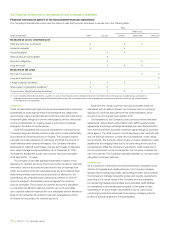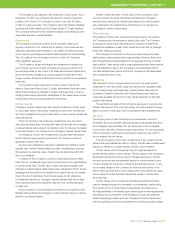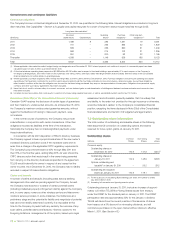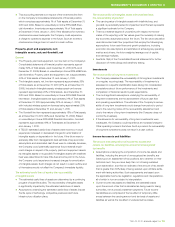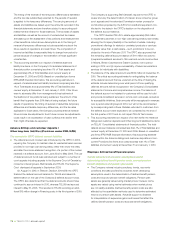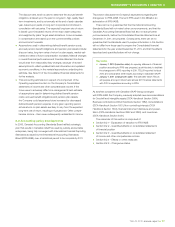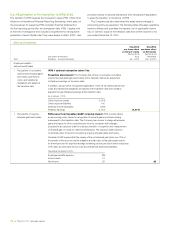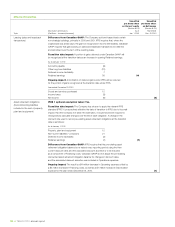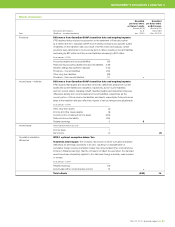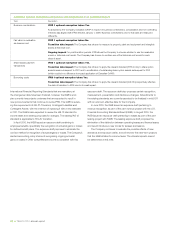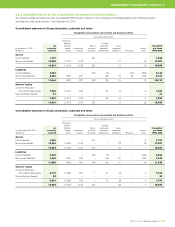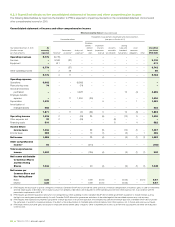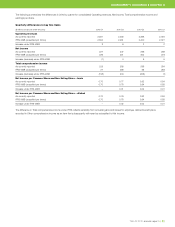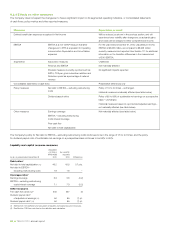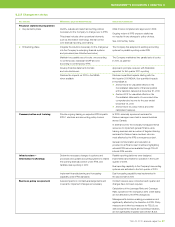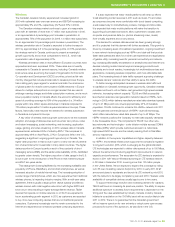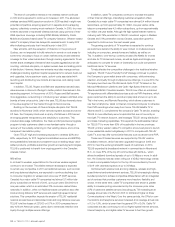Telus 2010 Annual Report Download - page 84
Download and view the complete annual report
Please find page 84 of the 2010 Telus annual report below. You can navigate through the pages in the report by either clicking on the pages listed below, or by using the keyword search tool below to find specific information within the annual report.
80 . TELUS 2010 annual report
Effects of transition
Topic
Unaudited Unaudited
pro forma effect pro forma effect
on Owners’ equity on Net income
(Section 8.2.2) (Section 8.2.3)
Description and impacts As at Year ended
($ millions – increase (decrease)) Jan. 1, 2010 Dec. 31, 2010
Leasing (sales and leaseback
transactions)
Difference from Canadian GAAP: The Company sold and leased-back certain
non-strategic buildings, primarily in 2000 and 2001. IFRS requires that, where the
original sale was at fair value, the gain be recognized in income immediately. Canadian
GAAP required that gains arising on sales and leaseback transactions be deferred
and amortized over the term of the resulting lease.
Transition date impact: A portion of gains deferred under Canadian GAAP will
be recognized at the transition date as an increase in opening Retained earnings.
As at January 1, 2010
Accounts payable (6)
Other long-term liabilities (31)
Deferred income tax liability 7
Retained earnings 30 30
Ongoing impact: Amortization of deferred gains under IFRS will be reduced
for the portion of gains recognized at the transition date under IFRS.
Year ended December 31, 2010
Goods and services purchased 12
Income taxes (3)
Net income (9) (9)
Asset retirement obligations
(Decommisioning liabilities
included in the cost of property,
plant and equipment)
IFRS 1 optional exemption taken: Yes.
Transition date impact: The Company has chosen to apply the relevant IFRS
standard (IFRIC 1) prospectively effective the date of transition to IFRS due to its small
impact. Had the Company not taken the exemption, it would have been required to
retrospectively calculate changes over the life of each obligation. A change in the
discount rate used to record pre-existing asset retirement obligations at the transition
date is as follows:
As at January 1, 2010
Property, plant and equipment 12
Non-current liabilities – provisions 21
Deferred income tax liability (2)
Retained earnings (7) (7)
Difference from Canadian GAAP: IFRS requires that the pre-existing asset
retirement obligation balance be re-valued every reporting period using the then
current discount rates and the associated discount accretion is to be included
as a component of Financing costs. Canadian GAAP did not adjust the pre-existing
discounted asset retirement obligation balance for changes in discount rates,
and the associated discount accretion was included in Operations expenses.
Ongoing impact: The result is a $4 million decrease in Operating expenses offset by
a $4 million increase in Financing costs, as well as a $1 million increase in Depreciation
expense for the year ended December 31, 2010. (1)


